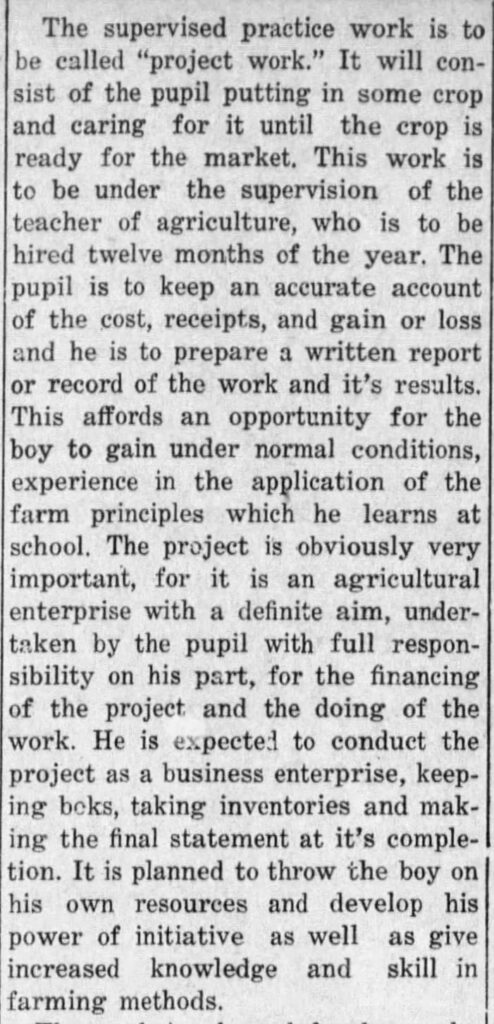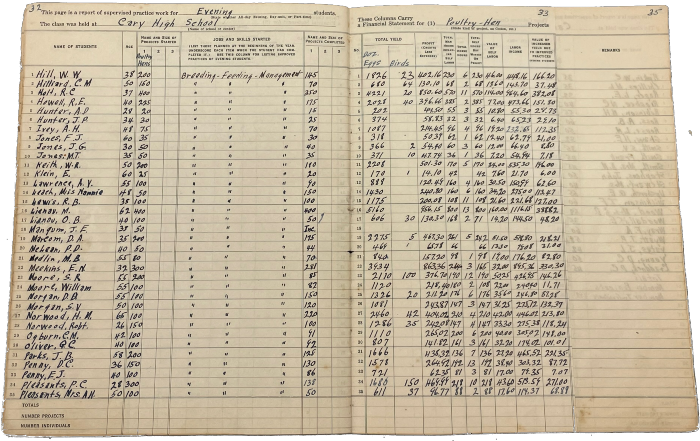An agriculture teacher (who will go unnamed) posted this on social media earlier this week:
Well, here it is, that most wonderful time of year: state/national FFA application week! The week where we celebrate forgotten journal entries, chasing down electronic signatures, and making balance sheets balance in ways that not even a CPA could understand…we will consider sacrificing our firstborn and/or other loved ones to the gods of the AET while secretly wishing we could just go back to paper applications.
Do we really want to go back to paper applications? Why stop there? Let’s go all the way back to the “good old days” of SAE record keeping (satire intended – some of us remember what it was really like). In this Friday Footnote we continue our Financial Literacy month observance by looking at record keeping in the early days of vocational agriculture.
In the Beginning
One of the provisions of the Smith-Hughes Act of 1917 required all agricultural students to have a farming project. Typically this was growing a crop or raising livestock. Not only did the student have to care for the crop or livestock, but the student also had to keep financial records on the project.
The Phillips County Post (Phillipsburg, Kansas) described what was expected of agriculture students under the Smith-Hughes Act in a June 26,1919 article titled “AGRICULTURE IN OUR SCHOOL”:

Figure 1. Article from Phillips County Post (Phillipsburg, Kansas). June 26, 1919
It should be stated at this point the requirement to have a farming project was a federal requirement. It had nothing to do with the FFA because it would be eleven more years before the FFA came into existence (in 1928). It is true FFA degree requirements are based on the student’s supervised agricultural (SAE) experience program, but these programs were in existence long before the FFA. So, referring to the students’ SAE program as being required or started by the FFA is inaccurate.
The Smith-Hughes Act also created a Federal Board for Vocational Education. The Federal Board provided direction for vocational education, made sure the law was being implemented as designed, and established policies and procedures. One of the first bulletins published by the Federal Board was titled “The Home Project as a Phase of Vocational Agricultural Education” in 1918 (Bulletin No. 21, Agricultural Series 3). This bulletin was updated and revised from time to time. The 1930 version of this bulletin (Supervised Practice in Agriculture Including Home Projects, Bulletin 112, Agricultural Series No. 29) listed a number of characteristics (really practices to be followed) for supervised practice. Characteristic 9 addressed record keeping (p. 23):

Figure 2. Record Keeping Requirement from Supervised Practice in Agriculture Including Home Projects, Bulletin 112, Agricultural Series No. 29, 1930.
One of the immediate challenges in teaching record keeping was to find or create a record book. Because of the diversity of agriculture in the various states, it was not possible to have a national record book. Each state was left to come up with their own record book.
In 1923 Roger Maltby, the Southern Region Agricultural Education supervisor with the Federal Board for Vocational Education studied the record books used in 24 different states. In Bulletin 83, Supervised Practice in Agriculture, Maltby stated (p. 49) “These books vary considerably in size, shape and content.” Maltby was somewhat surprised to discover 17 different sizes of record books. They ranged in size from fitting in a pocket to a 13” by 12½” size. Some record books were bound, stiff backed books while others were loose sheets of paper with no cover. The number of pages in the record books varied from 10 to 108.
Over the time covered by the Smith-Hughes Act (1917-1963) there were numerous record books from an assortment of sources. Some were created by state departments of education, some were sold by commercial publishers (such as Interstate and the French-Bray Printing Company), some were developed by banks or agricultural firms such as John Deere and provided at no charge to agriculture departments.

Figure 3. Top Left – Illinois record book 1940s, Top Right – John Deere record book 1940s, Bottom Left – North Carolina record book 1932, Bottom Right – French-Bray Record Book 1960s.
The agriculture teacher had to teach the student how to keep records which was a new challenge for many of the students. But what was even more challenging, the teacher had to prepare preliminary, periodical, and annual reports on the student’s supervised practice. These reports were submitted to the state and federal agricultural education officials.
In the study conducted by Maltby in 1923 he found “States have universally adopted some system of supervised practice recording and reporting. The systems in the various states vary somewhat and the details vary still more. However, quite universally States require teacher’s preliminary reports, periodical reports—usually monthly—annual summary of supervised practice by teacher or school to the state office.”
Maltby in the 1923 Federal Bulletin “Supervised Practice in Agriculture” clearly states this responsibility and why it is important (p. 27):

Figure 4. Federal Board for Vocational Education, Supervised Practice in Agriculture (Bulletin 83, Agricultural Series No. 14). U.S. Government Printing Office. 1923
It took a considerable amount of time to complete these reports. The teacher not only had to report on the supervised practice of the day students, but also on the adult students who might be taking an adult education course in agriculture. They were also required to have supervised practice. The image below shows the report for an evening class at a high school in North Carolina in 1930. The class was about poultry production, so all the students had the same type of poultry project.

Figure 5. Supervised Practice report for an adult class in poultry production.
At the end of the year the teacher had to prepare an overall summary of all students and their supervised practice. These reports typically listed every student in the agricultural classes, what type of agricultural enterprise the student had, yields were specified (pigs born, bushels produced, weight gained, etc.), and expenses and income associated with the project were recorded. See Figure 6.
The state officials would carefully check the reports submitted by the teachers and provide them feedback. This took a lot of time for the state officials and required substantial time for the teachers to prepare. State officials prepared a state summary and sent it to the Federal Board for Vocational Education.

Figure 6. The end of the year Supervised Practice Summary Report for Cary (NC) High School.
These reports were used to verify that the “supervised practice” required by the Smith-Hughes Act was being implemented. But the reports also served another purpose. Federal and state officials could show the value of agricultural education by touting the money being earned by the students. It was not uncommon to report on how much money was being spent in a state (and nationally) on the vocational agriculture program and how much money was being returned to the economy as a result. The figures showed that funding vocational agricultural programs was a wise investment of taxpayer dollars.
Concluding Remarks
So, do we really want to return to the days of filling out detailed paper reports based on entries in the student’s paper record books? I don’t think so.
Record keeping is an important skill. I remember hearing a report many years ago at a research conference where the researchers (I think it was David Williams and colleagues at Iowa State) found that record keeping was identified by past agricultural students as the most important skill they learned in their vocational agriculture classes.
While it may not be exciting and glamorous, it is important that we teach our students record keeping skills.
I personally have benefited from the record keeping skills my agriculture teacher taught me. When I was in college, I had a part-time job as the evening desk clerk at a motel. When the motel was sold to a big chain, I thought that job would disappear. The new manager asked if I would continue and after watching me for a couple of weeks wanted to know if I would be willing to also serve as the night auditor. He had taught me what needed to be done and my past record keeping experience kicked in. I readily agreed. To make a long story short, during my senior year in college I became the manager of the motel. Thank you, Mr. Lacy, for teaching me how to keep records.
